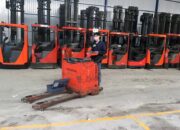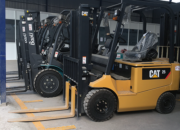Forklift trucks and forklift tires
Types of forklifts:
Forklift, forklift is known as a type of heavy-duty vehicle with a crane because it is a vehicle that can lift and lower loads using a set of forks (forks, pallets). Forklifts are used in many places such as warehouses, workshops, farms, freight warehouses, docks and more. There are many types of forklifts that are called by many different names; in this case samcovina.com will use the basic name of the forklift when describing its capabilities.

Pallet Trucks and Walkie Stackers (type II): commonly used to move pallets and small containers at a height near the ground.
Electric Warehouse Equipment – Type II and III: This type of forklift is used in small spaces and it is quite easy to move. This forklift can handle small to medium loads (Reach trucks, order pickers, turret trucks).
Electric Counter Balance Forklift – Type I: Used to lift medium to large loads with a single motor battery. The advantage of this type of forklift is that it is less polluting to the environment and is more suitable for lifting loads inside warehouses with lower operating costs.
IC (Internal Combustion – types IV and V) trucks: These forklifts are most commonly used outdoors. This type of forklift is usually cheaper to buy but is capable of lifting heavier loads. On the other hand, this forklift also works in all kinds of weather (rain or shine). The fuels used to operate it are liquid petroleum (LPG), liquid propane, diesel and compressed natural gas (CNG).
Big trucks: are vehicles that can lift extremely large loads up to 48 tons (for example, transporting containers to a very high height).
Forklift tires
Forklift tires are an extremely important part (spare part) because it will help the forklift to have maneuverability (move function) so that the forklift will maximize its loading and unloading function. user needs. Improper use of forklift tires and poor maintenance can lead to increased business costs for your business. When choosing tires will depend on the location and primary working environment of the forklift. There are three different types of tires including:

Pneumatic tires: Used in paved yards and on rough terrain.
Pneumatic Profile Puncture Proof (Semi-Solids): Used on sealed surfaces and where punctures can be a problem.
Cushion Tires: Used on many compact model forklifts in warehouse applications.
Non-Markers: Made to remove black marks on the floor.
There are many factors both externally and internally that can affect the life of forklift tires. If a forklift tire is punctured or broken, it can result in a forklift being damaged, damaged or misloaded, or even possibly causing injury to the operator. It can also be a hassle to order a replacement tire as it will take a lot of time, leading to a lot of forklift downtime. On the other hand, damaged forklift tires can increase your forklift maintenance costs and can have a huge impact on your budget.
Here are some factors that you can rely on and to maintain and care for to ensure your tires have a long and useful life.
External factors include: type of forklift truck, lifting conditions, duty cycle, ground conditions where the forklift is frequently used, the driver’s care, and the risk of external damage. how much?
– Internal factors: tire structure (what material? high or low durability, is the material mixed?), what is the thickness of the outer tire layer? How is the tire’s heat resistance? Should choose tires made of rubber compounds, non-marking tires are softer and faster to replace.
Samcovina.com hopes everyone has benefited from this knowledge. Whether this knowledge of forklifts is completely new or not? It is also the background knowledge for us to think about or discuss it will help you ask more questions, and provide more information when deciding to buy or rent a forklift in the future.







